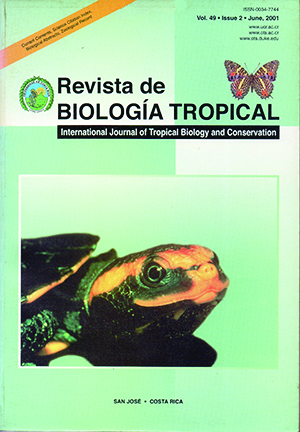Abstract
The diversity of a subtidal epifaunal mollusk community was studied from September, 1990 to September, 1991 in Chacopata, Sucre State, Venezuela. There were 40 species (24 bivalves and 16 gastropods). The diversity indexes (H' = 2.087, J' =0.392, 1/D = 0.528) were low when compared with other tropical zones. Monthly diversity reached its maximum in September, 1990 (1.63 bits/ind.) and July, 1991 (1.60 bits/ind.); minimum diversity occurred in June, 1991 (0.52 bits/ind.). A Log series model applied to species abundance data showed a straight line with a diversity index α of 5.56. Of 40 species identified, the turkeywing Arca zebra was dominant (69% in number of individuals and 72% of biomass) followed by Pinctada imbricata, Modiolus squamosus, Chama macerophyla and Anadara notabilis. The predatory snails Phyllonotus pomum, Chicoreus brevifrons and Murex recurvirostris seemed to have trophic relationships with A. zebra. The total mean biomass in wet weight (469.20 ± 263g m-2, shell included) was high which indicates that A. zebra, a species with a rapid growth rate, occupies a central role in the assemblage as an efficient filter feeder that converts planktonic food into available biomass, supporting one of the most important fisheries in Venezuela.Comments

This work is licensed under a Creative Commons Attribution 4.0 International License.
Copyright (c) 2001 Revista de Biología Tropical
Downloads
Download data is not yet available.


